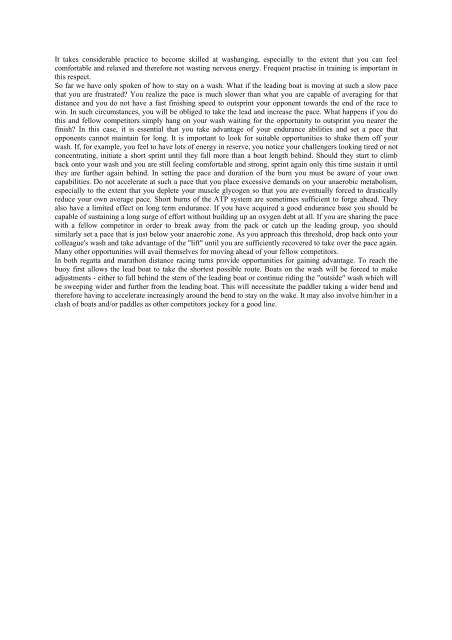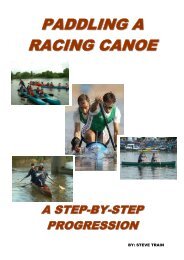The Science of Canoeing By Richard Cox
The Science of Canoeing By Richard Cox
The Science of Canoeing By Richard Cox
You also want an ePaper? Increase the reach of your titles
YUMPU automatically turns print PDFs into web optimized ePapers that Google loves.
It takes considerable practice to become skilled at washanging, especially to the extent that you can feel<br />
comfortable and relaxed and therefore not wasting nervous energy. Frequent practise in training is important in<br />
this respect.<br />
So far we have only spoken <strong>of</strong> how to stay on a wash. What if the leading boat is moving at such a slow pace<br />
that you are frustrated? You realize the pace is much slower than what you are capable <strong>of</strong> averaging for that<br />
distance and you do not have a fast finishing speed to outsprint your opponent towards the end <strong>of</strong> the race to<br />
win. In such circumstances, you will be obliged to take the lead and increase the pace. What happens if you do<br />
this and fellow competitors simply hang on your wash waiting for the opportunity to outsprint you nearer the<br />
finish? In this case, it is essential that you take advantage <strong>of</strong> your endurance abilities and set a pace that<br />
opponents cannot maintain for long. It is important to look for suitable opportunities to shake them <strong>of</strong>f your<br />
wash. If, for example, you feel to have lots <strong>of</strong> energy in reserve, you notice your challengers looking tired or not<br />
concentrating, initiate a short sprint until they fall more than a boat length behind. Should they start to climb<br />
back onto your wash and you are still feeling comfortable and strong, sprint again only this time sustain it until<br />
they are further again behind. In setting the pace and duration <strong>of</strong> the burn you must be aware <strong>of</strong> your own<br />
capabilities. Do not accelerate at such a pace that you place excessive demands on your anaerobic metabolism,<br />
especially to the extent that you deplete your muscle glycogen so that you are eventually forced to drastically<br />
reduce your own average pace. Short burns <strong>of</strong> the ATP system are sometimes sufficient to forge ahead. <strong>The</strong>y<br />
also have a limited effect on long term endurance. If you have acquired a good endurance base you should be<br />
capable <strong>of</strong> sustaining a long surge <strong>of</strong> effort without building up an oxygen debt at all. If you are sharing the pace<br />
with a fellow competitor in order to break away from the pack or catch up the leading group, you should<br />
similarly set a pace that is just below your anaerobic zone. As you approach this threshold, drop back onto your<br />
colleague's wash and take advantage <strong>of</strong> the "lift" until you are sufficiently recovered to take over the pace again.<br />
Many other opportunities will avail themselves for moving ahead <strong>of</strong> your fellow competitors.<br />
In both regatta and marathon distance racing turns provide opportunities for gaining advantage. To reach the<br />
buoy first allows the lead boat to take the shortest possible route. Boats on the wash will be forced to make<br />
adjustments - either to fall behind the stern <strong>of</strong> the leading boat or continue riding the "outside" wash which will<br />
be sweeping wider and further from the leading boat. This will necessitate the paddler taking a wider bend and<br />
therefore having to accelerate increasingly around the bend to stay on the wake. It may also involve him/her in a<br />
clash <strong>of</strong> boats and/or paddles as other competitors jockey for a good line.



